A few months ago, I bought a walk-behind DR brush cutter to clear several overgrown acres in the back half of our new weekend property in Lamar County, Texas. In our part of the world we usually use tractors with bush hogs dragging behind, but I didn’t want to lay out the capital for such a big rig, hence the DR.
This thing is a beast that chews up saplings three inches in diameter without even struggling to clear its throat. Chest-high Johnson grass and weeds? No problem. It shreds that kind of vegetation with satisfying, crunching sounds reminiscent of a sharp knife cutting through limp celery.
The front stretches out like the hood of a ’76 Ford Thunderbird and the monster cutter is driven by an engine big enough to power that same car. The belt drive will yank it from your hands in third gear, so the only thing one has to do is engage the blade thick as a Roman broadsword and follow…sometimes reluctantly when the terrain forces a veer off the operator’s intended path.
One such unplanned shift in direction took me through a thick patch of head-high thorny blackberry vines and oak saplings, resulting in long, bloody scratches down my arms. However, when I looked back, the new lane was clear as a walking path in a city park.
Hang on, Ethyl, I think this boy’s gonna start reminiscing!
The whole thing reminded me of a scene that locked into my mind about twenty years ago when the legendary Y.O. Ranch in South Texas hosted a weekend cattle drive for outdoor writers and one of their children. Our youngest daughter who was thirteen at the time, nickname Taz, is a natural on horses and she was excited to go.
It was a real three-day cattle drive across that huge 40,000-acre ranch, moving a hundred or more longhorns from one pasture to another. On the first day, cowboys taught the city slickers how to ride, and later that evening kids learned to cook over an open campfire. It was a breeze for Taz, who grew up camping with us and already knew how to ride.
We pushed the herd on the second morning under a gray, leaden sky weeping with rain. The herd’s trail boss made it clear that if “things got western,” kids and dads were to get the hell out of the way and let the real cowboys handle the herd.
Ten experienced cowhands circled the cattle and pushed them into a long string through the first pasture full of prairie savanna grasses, cedars, and ragged mesquite. Mounted kids and dads filled in the loose circle of riders, walking their horses in pace with the longhorns and cowboys who looked to be straight out of casting.
I was riding point with the trail boss and Taz was halfway back when something spooked the tough, rangy longhorns. The leaders instinctively wheeled and charged into a thicket of fifteen-foot-high mesquite trees lining a dry wash. The rest of the herd followed, ignoring the experienced cattlemen’s attempts to stop them.
In the Trail Boss’s terms, things got western.
He spurred his horse and took off to the right and around the end of that big patch of crooked trees, intending to cut the herd’s leaders off and turn them until the rest of the cowboys punched through the dense foliage to help. Reins in one hand and a 35mm camera in the other, I followed right behind him and watched that man sit his horse like he’d been born in a saddle. Not nearly as graceful in the saddle, I held my own and we beat the herd coming through the brush and reined up in a small clearing to experience a scene straight from the 1880s.
The running cattle sounded as if a steamfoller was crashing through the thicket. Branches and limbs popped and crackled, hooves thundered on the ground, and whoops reached our ears both from kids and cowboys.
Then here they came. The leaders exploded through the thicket in a blast of dust and flying leaves with broken limbs and dead branches caught on their horns. The real cowboys popped out on both sides of the herd, doing their best to keep the cattle from scattering to the winds. My breath caught at the sight of a scratched and bloody kid bent low over the saddle horn to avoid the limbs, holding her hat with one hand, and riding like hell.
She passed us and flashed me a grin full of excitement and fun.
The trail boss roared and pointed. “Who the hell belongs to that kid?”
I raised a hand, expecting a good old fashioned dressing down in a cowboy way.
Instead, he built his own grin. “That little gal can ride with me any day!”
They passed, and I looked through a newly cleared lane stomped flat by hooves and huge bodies to see the rest of the kids and their fathers picking their way through the undergrowth.
Under a similar gray sky yesterday in Northeast Texas, I turned after unintentionally following the DR brush cutter through a ten-foot-high thicket of saplings and blackberry vines and the new lane looked similar to the one pounded flat by that runaway herd
So what does all this have to do with writing?
Creating your characters, building a scene, and then setting those fictional people on course is like starting that cattle drive. We’d planned to follow a two-track pasture road that day, an outline if you wish, but the thing turned on a dime.
I hadn’t planned on that lane the other day, just like Trail Boss hadn’t planned on his longhorns cutting a new path through the mesquites, but I was glad for the experience and such satisfying results, both times
My way of writing is to set everything into motion and then follow the plot as it turns when it wants, but those of you who outline may shriek and throw up your hands at veering off your course and abandoning your outline. Planners must push their characters say and do certain things at specific points in a manuscript, but wait a second.
Try this little exercise just once. Let your mind wander through five or six new pages, allowing your characters’ fictional personalities to find their way. They might turn around a sapling (read minor character), a mature oak (one of your major characters), or an unseen obstacle such as a dip or dry wash (clues or an unanticipated incident) and cut a different, open path that you can look back on with satisfaction.
What could a few bloody, mental scratches hurt in the long run?

 Three days ago (Tuesday), my wife and I sold an office building where I had practiced medicine for thirty-five years of my 40-year career.
Three days ago (Tuesday), my wife and I sold an office building where I had practiced medicine for thirty-five years of my 40-year career.
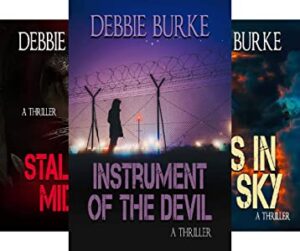



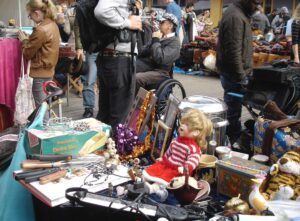
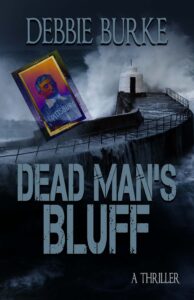 The fourth book in my series,
The fourth book in my series, 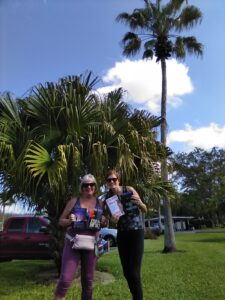



 Today I begin an occasional feature—JSB at the Movies. I’m a lifelong movie fan, my B.A. is in Film Studies, and I often use movie clips in my craft workshops. The crossover between screen and page storytelling is substantial.
Today I begin an occasional feature—JSB at the Movies. I’m a lifelong movie fan, my B.A. is in Film Studies, and I often use movie clips in my craft workshops. The crossover between screen and page storytelling is substantial.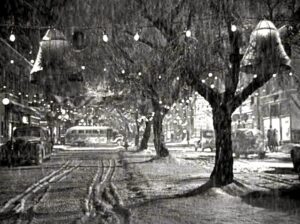 Wonderful Life begins and ends on the same Christmas Eve, in a town called Bedford Falls. It opens with shots of the snowy town, and the voices of various townspeople praying for a man named George Bailey. The last voice is the one we’ll come to know as Zuzu (George’s youngest child) pleading, “Please bring Daddy back!”
Wonderful Life begins and ends on the same Christmas Eve, in a town called Bedford Falls. It opens with shots of the snowy town, and the voices of various townspeople praying for a man named George Bailey. The last voice is the one we’ll come to know as Zuzu (George’s youngest child) pleading, “Please bring Daddy back!”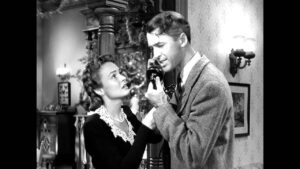 George Bailey (James Stewart) is a good man, a solid citizen, but is far from perfect. He’s not above leering at the attractive derrière of Violet Bick (Gloria Grahame) as she shimmies down the street. He loses his temper and becomes abusive. He verbally destroys the simple-minded Uncle Billy when the latter loses a crucial bank deposit. On Christmas Eve, his life at its lowest ebb, he screams over the phone at his child’s teacher, then yells at his children, bringing them to tears. (Stewart’s acting is brilliant throughout. He was suitably nominated for Best Actor, losing only because the equally brilliant Frederic March in The Best Years of Our Lives.)
George Bailey (James Stewart) is a good man, a solid citizen, but is far from perfect. He’s not above leering at the attractive derrière of Violet Bick (Gloria Grahame) as she shimmies down the street. He loses his temper and becomes abusive. He verbally destroys the simple-minded Uncle Billy when the latter loses a crucial bank deposit. On Christmas Eve, his life at its lowest ebb, he screams over the phone at his child’s teacher, then yells at his children, bringing them to tears. (Stewart’s acting is brilliant throughout. He was suitably nominated for Best Actor, losing only because the equally brilliant Frederic March in The Best Years of Our Lives.)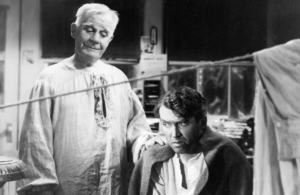 Every one of the secondary characters in Wonderful Life is well-drawn and engaging in their own right. Clarence the Angel (Henry Travers); Bert the cop (Ward Bond); Ernie the cab driver (Frank Faylen); the tragic Mr. Gower (H. B. Warner); all the way down to Zuzu (Karolyn Grimes, who is still with us). Old Man Potter (Lionel Barrymore) is a classic villain, and even his nonspeaking servant has an eerie presence.
Every one of the secondary characters in Wonderful Life is well-drawn and engaging in their own right. Clarence the Angel (Henry Travers); Bert the cop (Ward Bond); Ernie the cab driver (Frank Faylen); the tragic Mr. Gower (H. B. Warner); all the way down to Zuzu (Karolyn Grimes, who is still with us). Old Man Potter (Lionel Barrymore) is a classic villain, and even his nonspeaking servant has an eerie presence.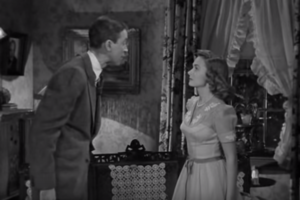 Which doesn’t help George’s frustration about staying in town. That evening he finds himself walking by Mary Hatch’s house. Mary, back in town from school, has been waiting for this moment. She has on her best dress and has set up the parlor to reveal a picture of a romantic moment from their high school days—when George said he would “lasso the moon” for Mary.
Which doesn’t help George’s frustration about staying in town. That evening he finds himself walking by Mary Hatch’s house. Mary, back in town from school, has been waiting for this moment. She has on her best dress and has set up the parlor to reveal a picture of a romantic moment from their high school days—when George said he would “lasso the moon” for Mary.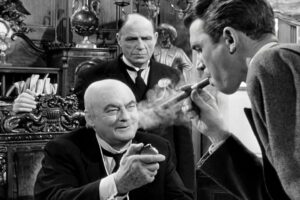 “You wouldn’t mind living in the nicest house in town,” Potter says, “buying your wife a lot of fine clothes, a couple of business trips to New York a year, maybe once in a while Europe. You wouldn’t mind that, would you, George?”
“You wouldn’t mind living in the nicest house in town,” Potter says, “buying your wife a lot of fine clothes, a couple of business trips to New York a year, maybe once in a while Europe. You wouldn’t mind that, would you, George?”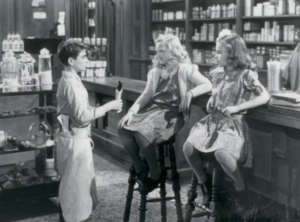 In Wonderful Life, George’s realization about his town’s love is argued against in Act 1. That’s when the young George Bailey tells the two girls, Mary and Violet, the following:
In Wonderful Life, George’s realization about his town’s love is argued against in Act 1. That’s when the young George Bailey tells the two girls, Mary and Violet, the following: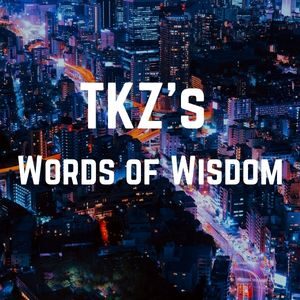
 Do you judge a book by its cover?
Do you judge a book by its cover?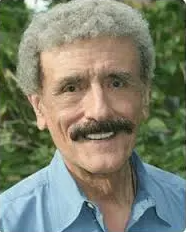 “Hypnosis is a natural state of consciousness that we drift in and out of quite regularly. For example, while driving along a highway and then suddenly discovering that you ‘lost’ several miles without being aware of it. This can also happen during reading when you may notice that you have ‘read’ a chapter or two without being mindful of the content. Hypnosis is basically a technique for focusing consciousness by entering a deep state of absorption. It allows you to shift from your outer to inner awareness and tap deeper levels of consciousness so we can re-educate and reprogram the subconscious with empowering suggestions or beliefs.”
“Hypnosis is a natural state of consciousness that we drift in and out of quite regularly. For example, while driving along a highway and then suddenly discovering that you ‘lost’ several miles without being aware of it. This can also happen during reading when you may notice that you have ‘read’ a chapter or two without being mindful of the content. Hypnosis is basically a technique for focusing consciousness by entering a deep state of absorption. It allows you to shift from your outer to inner awareness and tap deeper levels of consciousness so we can re-educate and reprogram the subconscious with empowering suggestions or beliefs.”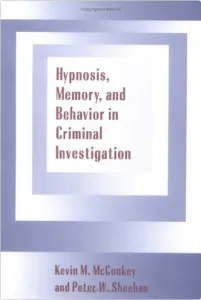 “Hypnosis,” says Kevin McConkey, President of the Australian Psychological Society and co-author of Hypnosis, Memory, and Behavior in Criminal Investigation, “is essentially a phenomenon that reflects genuinely experienced alterations of reality in response to suggestions administered by a hypnotist. The subject’s testimony is what confirms the trance, although susceptibility varies among individuals. Those who are highly suggestive will behave as if going through truly significant cognitive alterations.”
“Hypnosis,” says Kevin McConkey, President of the Australian Psychological Society and co-author of Hypnosis, Memory, and Behavior in Criminal Investigation, “is essentially a phenomenon that reflects genuinely experienced alterations of reality in response to suggestions administered by a hypnotist. The subject’s testimony is what confirms the trance, although susceptibility varies among individuals. Those who are highly suggestive will behave as if going through truly significant cognitive alterations.”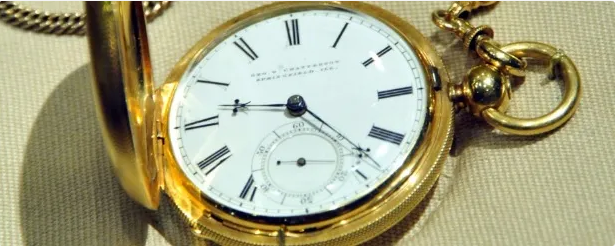
 In wintery April, an elderly lady in her 70s was alone in her cabin on a remote gold claim in northern British Columbia. A masked man with a handgun appeared at her door, demanding she hand over her gold stash. She refused. He proceeded to blindfold and hog-tie her, then began torturing by burning her hands and ribs with a red-hot knife heated on her wood stove.
In wintery April, an elderly lady in her 70s was alone in her cabin on a remote gold claim in northern British Columbia. A masked man with a handgun appeared at her door, demanding she hand over her gold stash. She refused. He proceeded to blindfold and hog-tie her, then began torturing by burning her hands and ribs with a red-hot knife heated on her wood stove.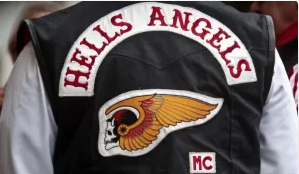 Now knowing an accomplice was involved, we focused the investigation on a neighbor who’d been involved with a gold claim boundary dispute. We identified the suspect as a Hells Angels striker who’d been hired by the neighbor, so we ran a wiretap which caught him using the term ‘squirreled away’. This led to an elaborate, clandestine sting operation resulting in his confession to an undercover agent. He was convicted and got twenty years.
Now knowing an accomplice was involved, we focused the investigation on a neighbor who’d been involved with a gold claim boundary dispute. We identified the suspect as a Hells Angels striker who’d been hired by the neighbor, so we ran a wiretap which caught him using the term ‘squirreled away’. This led to an elaborate, clandestine sting operation resulting in his confession to an undercover agent. He was convicted and got twenty years.